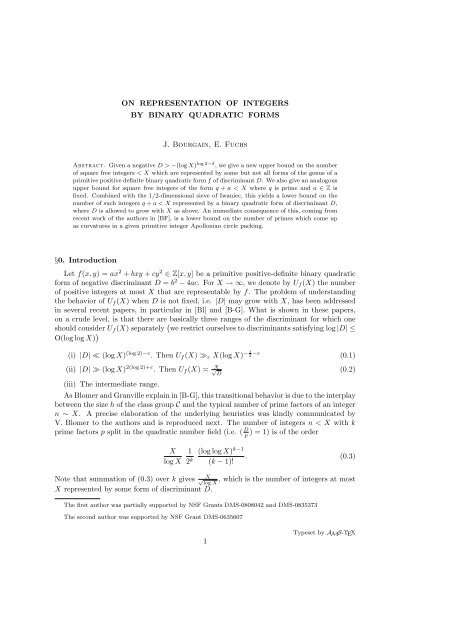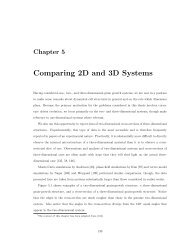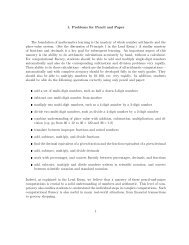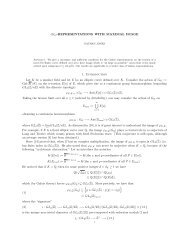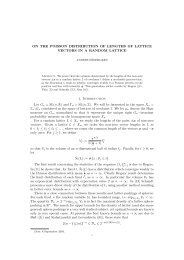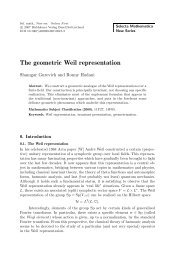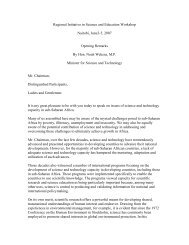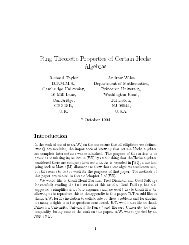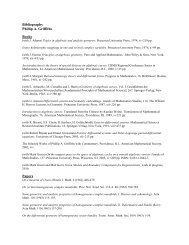On representation of integers by binary quadratic forms - IAS
On representation of integers by binary quadratic forms - IAS
On representation of integers by binary quadratic forms - IAS
Create successful ePaper yourself
Turn your PDF publications into a flip-book with our unique Google optimized e-Paper software.
ON REPRESENTATION OF INTEGERS<br />
BY BINARY QUADRATIC FORMS<br />
J. Bourgain, E. Fuchs<br />
Abstract. Given a negative D > −(log X) log 2−δ , we give a new upper bound on the number<br />
<strong>of</strong> square free <strong>integers</strong> < X which are represented <strong>by</strong> some but not all <strong>forms</strong> <strong>of</strong> the genus <strong>of</strong> a<br />
primitive positive definite <strong>binary</strong> <strong>quadratic</strong> form f <strong>of</strong> discriminant D. We also give an analogous<br />
upper bound for square free <strong>integers</strong> <strong>of</strong> the form q + a < X where q is prime and a ∈ Z is<br />
fixed. Combined with the 1/2-dimensional sieve <strong>of</strong> Iwaniec, this yields a lower bound on the<br />
number <strong>of</strong> such <strong>integers</strong> q + a < X represented <strong>by</strong> a <strong>binary</strong> <strong>quadratic</strong> form <strong>of</strong> discriminant D,<br />
where D is allowed to grow with X as above. An immediate consequence <strong>of</strong> this, coming from<br />
recent work <strong>of</strong> the authors in [BF], is a lower bound on the number <strong>of</strong> primes which come up<br />
as curvatures in a given primitive integer Apollonian circle packing.<br />
§0. Introduction<br />
Let f(x, y) = ax 2 + bxy + cy 2 ∈ Z[x, y] be a primitive positive-definite <strong>binary</strong> <strong>quadratic</strong><br />
form <strong>of</strong> negative discriminant D = b 2 − 4ac. For X → ∞, we denote <strong>by</strong> U f (X) the number<br />
<strong>of</strong> positive <strong>integers</strong> at most X that are representable <strong>by</strong> f. The problem <strong>of</strong> understanding<br />
the behavior <strong>of</strong> U f (X) when D is not fixed, i.e. |D| may grow with X, has been addressed<br />
in several recent papers, in particular in [Bl] and [B-G]. What is shown in these papers,<br />
on a crude level, is that there are basically three ranges <strong>of</strong> the discriminant for which one<br />
should consider U f (X) separately ( we restrict ourselves to discriminants satisfying log |D| ≤<br />
O(log log X) )<br />
(i) |D| ≪ (log X) (log 2)−ε . Then U f (X) ≫ ε X(log X) − 1 2 −ε (0.1)<br />
(ii) |D| ≫ (log X) 2(log 2)+ε . Then U f (X) ≍ X √<br />
D<br />
(0.2)<br />
(iii) The intermediate range.<br />
As Blomer and Granville explain in [B-G], this transitional behavior is due to the interplay<br />
between the size h <strong>of</strong> the class group C and the typical number <strong>of</strong> prime factors <strong>of</strong> an integer<br />
n ∼ X. A precise elaboration <strong>of</strong> the underlying heuristics was kindly communicated <strong>by</strong><br />
V. Blomer to the authors and is reproduced next. The number <strong>of</strong> <strong>integers</strong> n < X with k<br />
prime factors p split in the <strong>quadratic</strong> number field (i.e. ( D p<br />
) = 1) is <strong>of</strong> the order<br />
X<br />
log X<br />
1 (log log X) k−1<br />
2 k . (0.3)<br />
(k − 1)!<br />
X<br />
Note that summation <strong>of</strong> (0.3) over k gives √ log X<br />
, which is the number <strong>of</strong> <strong>integers</strong> at most<br />
X represented <strong>by</strong> some form <strong>of</strong> discriminant D.<br />
The first author was partially supported <strong>by</strong> NSF Grants DMS-0808042 and DMS-0835373<br />
The second author was supported <strong>by</strong> NSF Grant DMS-0635607<br />
1<br />
Typeset <strong>by</strong> AMS-TEX
Moreover, applying Stirling’s formula, we see that the main contribution comes from<br />
<strong>integers</strong> with k ∼ 1 2<br />
log log X prime factors.<br />
Next, ignoring ambiguous classes, these k primes yield 2 k classes (with possible repetition)<br />
in C that represent the given integer n. Hence, roughly speaking, one would expect that<br />
typically n is represented <strong>by</strong> each class <strong>of</strong> its genus provided 2 k ≫ h, which amounts to<br />
corresponding to alternative (i).<br />
h < (log X) log 2<br />
2 −ε (0.4)<br />
<strong>On</strong> the other hand, if D is sufficiently large, the 2 k classes will be typically distinct.<br />
Assuming some mild form <strong>of</strong> equidistribution in the class group when varying n, we expect<br />
for the number <strong>of</strong> <strong>integers</strong> n < X with k prime factors represented <strong>by</strong> a given class to be <strong>of</strong><br />
order<br />
(<br />
with total contribution O<br />
there is no difference between h and √ D).<br />
X<br />
h<br />
2 k<br />
X<br />
h log X<br />
(log log X) k−1<br />
(k − 1)!<br />
h · (0.3) =<br />
(0.5)<br />
)<br />
, attained when k ∼ log log X (at this level <strong>of</strong> the discussion,<br />
In this paper, we consider only the lower range (i). Our aim is to substantiate further the<br />
heuristic discussed above according to which, typically, all classes <strong>of</strong> the genus <strong>of</strong> n ∼ X, n<br />
representable <strong>by</strong> a form <strong>of</strong> discriminant D, do actually represent n.<br />
More precisely, we prove the following (as consequence <strong>of</strong> Theorem 2 in [B-G]).<br />
Theorem 2’. Let D be a negative discriminant satisfying<br />
for some fixed δ > 0. Then there is δ ′ = δ ′ (δ) > 0 such that<br />
|D| < (log X) log 2−δ (0.6)<br />
#{n ∼ X; n square free, representable <strong>by</strong> some form <strong>of</strong> discriminant D but not <strong>by</strong> all <strong>forms</strong><br />
<strong>of</strong> the genus}<br />
X<br />
<<br />
. (0.7)<br />
(log X) 1 2 +δ′<br />
Note that though [Bl], [B-G] establish (0.1) (in fact in a more precise form, cf. Theorem<br />
5 in [B-G]), their results do not directly pertain to the phenomenon expressed in Theorem<br />
2’. As pointed out in [B-G], it was shown on the other hand <strong>by</strong> Bernays that almost all<br />
<strong>integers</strong> represented <strong>by</strong> some form in a given genus can be represented <strong>by</strong> all <strong>forms</strong> in the<br />
genus, but assuming the much stronger restriction<br />
D ≪ (log log X) 1 2 −ε . (0.8)<br />
A result in the same spirit was also obtained <strong>by</strong> Golubeva [Go].<br />
The pro<strong>of</strong> <strong>of</strong> Theorem 2’ rests on a general result from arithmetic combinatorics (Theorem<br />
1 below) that we describe next. Assume G a finite abelian group (G = C 2 in our application)<br />
in which group operation will be denoted additively. Given a subset A ⊂ G, we introduce<br />
the set<br />
{ ∑ }<br />
s(A) = xi ; {x i } are distinct elements <strong>of</strong> A . (0.9)<br />
2
The issue is then to understand what it means for A that s(A) ≠ G, which is the undesirable<br />
outcome for our purposes. It turns out that there are basically two possibilities. In the first,<br />
A is contained, up to a bounded number <strong>of</strong> elements, in a proper subgroup H <strong>of</strong> G <strong>of</strong><br />
bounded index [G:H]. In our application to the class group in Section 2, we give an upper<br />
bound on the number <strong>of</strong> possibilities for such A.<br />
The second scenario is as follows. There are k elements x 1 , . . . , x k ∈ A with<br />
log |G|<br />
k < (1 + ε)<br />
log 2<br />
(0.10)<br />
and a subset Ω x1,... ,x k<br />
⊂ G (determined <strong>by</strong> x 1 , . . . , x k ), such that A ⊂ Ω x1,... ,x k<br />
and<br />
|Ω x1,... ,x k<br />
| < ε|G| (0.11)<br />
(we are assuming here that |G| is large). Note that this second scenario occurs in some sense<br />
very rarely. Specifically, denote <strong>by</strong> K the upper bound on k in (0.10), and let |A| ∼ m,<br />
where in our application m ∼ K · (1 + a) for a small fixed a > 0, and m corresponds to the<br />
typical number <strong>of</strong> prime factors <strong>of</strong> an integer < X represented <strong>by</strong> the genus <strong>of</strong> f. There are<br />
( h<br />
′) (<br />
m possible choices for such A, and <strong>of</strong> these at most h<br />
′) (<br />
K · εh<br />
′<br />
m−K)<br />
sets A which fall into<br />
the second scenario. For small ε, the latter is much smaller than ( h<br />
m) ′<br />
, and in this sense this<br />
undesirable scenario is relatively rare.<br />
To prove Theorem 1, one applies the greedy algorithm. Thus given x 1 , . . . , x k ∈ A, we<br />
select x k+1 ∈ A as to optimize the size <strong>of</strong> s(x 1 , . . . , x k+1 ). If we do not reach s(x 1 , . . . , x k ) =<br />
G with k satisfying (0.10), then<br />
where the elements x ∈ Ω have the property that<br />
A ⊂ {x 1 , . . . , x k } ∪ Ω (0.12)<br />
|s(x 1 , . . . , x k , x)| ≈ |s(x 1 , . . . , x k )|. (0.13)<br />
Assuming Ω fails (0.11), the first alternative is shown to occur. The argument involves<br />
combinatorial results, such as a version <strong>of</strong> the Balog-Szemeredi-Gowers theorem and also<br />
Kneser’s theorem. The reader is referred to the book [T-V] for background material on the<br />
matter.<br />
<strong>On</strong>ce Theorem 1 is established, deriving Theorem 2 is essentially routine. We make use,<br />
<strong>of</strong> course, <strong>of</strong> Landau’s result [L2] (established in [Bl] with uniformity in the discriminant),<br />
on the distribution <strong>of</strong> the primes represented <strong>by</strong> a given class C ∈ C – namely, for P C the<br />
set <strong>of</strong> primes represented <strong>by</strong> a class C,<br />
|{p ∈ P C ; p ≤ ξ}| = 1 ∫ ξ<br />
dt<br />
ε(C)h 1 log t + C(ξe−c√ log ξ ) (0.14)<br />
for ξ → ∞, with ε(C) = 2 if C is ambiguous and ε(C) = 1 otherwise.<br />
The nontrivial upper bound (0.7) is then obtained <strong>by</strong> excluding certain additional prime<br />
divisors, i.e. satisfying ( )<br />
D<br />
p ≠ −1, using standard upper bound sieving.<br />
The same approach permits to obtain a similar result considering now shifted primes, i.e.<br />
<strong>integers</strong> n <strong>of</strong> the form n = a + q with a fixed and q a prime number. Thus<br />
3
Theorem 3’. Under the assumption (0.6), fixing a ∈ Z, we have<br />
|{q + a ∼ X; q prime, q + a squarefree representable <strong>by</strong> some form <strong>of</strong> discriminant D but<br />
not <strong>by</strong> all <strong>forms</strong> <strong>of</strong> the genus} |<br />
X<br />
<<br />
. (0.15)<br />
(log X) 3 2 +δ′<br />
<strong>On</strong> the technical side, only crude sieving bounds are needed for our purpose and they<br />
can be obtained <strong>by</strong> the simple inclusion/exclusion principle without the need <strong>of</strong> Brun’s<br />
theory. The arguments covering the specific problem at hand were included in the paper<br />
(see Lemmas 4 and 5), which turned out to be more convenient than searching for a reference.<br />
Note that the pro<strong>of</strong> <strong>of</strong> Lemma 5 involves sieving in the ideals and the required remainder<br />
estimates are provided <strong>by</strong> Landau’s extension <strong>of</strong> the Polya-Vinogradov inequality for Hecke<br />
characters [L1].<br />
The motivation behind Theorem 3’ lies in a result due to H. Iwaniec [Iw] on the number<br />
<strong>of</strong> shifted primes that are representable <strong>by</strong> the genus <strong>of</strong> a <strong>quadratic</strong> form. This in turn is<br />
applicable to counting primes which appear as curvatures in a primitive integer Apollonian<br />
circle packing using a method similar to that in [BF], where the authors prove that the<br />
<strong>integers</strong> appearing as curvatures in a primitive integer Apollonian packing make up a positive<br />
fraction <strong>of</strong> Z.<br />
Specifically, let P be a primitive integer Apollonian packing, and let a ≠ 0 denote a<br />
curvature <strong>of</strong> a circle in P . From [BF], we have that the set S a <strong>of</strong> <strong>integers</strong> less than X<br />
represented <strong>by</strong> certain shifted <strong>binary</strong> <strong>quadratic</strong> <strong>forms</strong> f a (x, y) − a, where the discriminant<br />
D(f a ) = −4a 2 , is contained in the set <strong>of</strong> curvatures <strong>of</strong> circles in P . Let P a ⊂ S a denote<br />
the set <strong>of</strong> primes in S a . We may then compute a lower bound for the number <strong>of</strong> primes less<br />
than X appearing as curvatures in P <strong>by</strong> bounding<br />
∣ ⋃ ∣<br />
P a a<br />
where the a’s range over a set <strong>of</strong> our choice. The aim is to use the 1 2-dimensional sieve <strong>of</strong><br />
Iwaniec to first determine the cardinality <strong>of</strong> P a . In [Iw], Iwaniec proves upper and lower<br />
bounds for the number <strong>of</strong> primes less than N represented <strong>by</strong> φ(x, y) + A, where φ(x, y) is a<br />
positive definite <strong>binary</strong> <strong>quadratic</strong> form and A is an integer. He shows<br />
X<br />
X<br />
≪ S(X, φ, a) ≪<br />
(log X)<br />
3/2<br />
(log X) 3/2<br />
where S(X, φ, a) denotes the number <strong>of</strong> primes less than X represented <strong>by</strong> φ(x, y)+A. Here<br />
the discriminant <strong>of</strong> φ is fixed, and the bounds above are obtained <strong>by</strong> considering the count<br />
over all <strong>forms</strong> in the genus <strong>of</strong> φ: namely, for fixed discriminant, bounds for S(X, φ, a) are<br />
easily derived from bounds for<br />
∑<br />
S 1 (X, φ, a) =<br />
1<br />
p≤X<br />
(x,y)=1,f∈R φ<br />
p=f(x,y)+a<br />
where R φ denotes the genus <strong>of</strong> φ. In order to apply this to finding bounds for |P a | where<br />
a is allowed to grow with X, we must understand both how S 1 (X, φ, a) depends on the<br />
discriminant <strong>of</strong> φ, and how S relates to S 1 in the case that D is not fixed. The latter<br />
is explained <strong>by</strong> Theorem 3’ for D satisfying (0.6), while the former is done via a careful<br />
analysis <strong>of</strong> the dependence on the discriminant in [Iw] for D < log X. This is discussed in<br />
the Appendix. Note that in the application to Apollonian packings, the discriminant <strong>of</strong> φ<br />
is always <strong>of</strong> the form −4a 2 , but our results apply to a more general discriminant.<br />
Indeed, Theorem 1 in [Iw] combined with Theorem 3’ above implies the following<br />
4
Corollary 4. Let D < 0 satisfy (0.6) and f be a primitive positive definite <strong>binary</strong> form <strong>of</strong><br />
discriminant D. Then<br />
|{q + a ∼ X; q prime, q + a representable <strong>by</strong> f}| ≫<br />
X<br />
(log X) 3 2 +ε (0.16)<br />
(we assume here a ∈ Z fixed for simplicity).<br />
Acknowledgement: The authors are grateful to V. Blomer for several private communications,<br />
as well as B. Green for helpful suggestions on a previous version <strong>of</strong> this paper.<br />
§1. A result in combinatorial group theory<br />
The aim <strong>of</strong> this section is to prove Theorem 1 below.<br />
(1). Let G be an abelian group, |G| = h ′ .<br />
For A ⊂ G, denote <strong>by</strong><br />
{ ∑ }<br />
s(A) = xi ; {x i } distinct elements <strong>of</strong> A<br />
(1.0)<br />
the set <strong>of</strong> sums <strong>of</strong> distinct elements <strong>of</strong> A.<br />
Assume s(A) ≠ G. We would like to specify the structure <strong>of</strong> such A.<br />
Start with the following algorithm. Take x 1 ∈ A. Assume we have obtained x 1 , . . . , x j ,<br />
take x j+1 as to maximize<br />
s(x 1 , . . . , x j+1 ).<br />
Let δ j = |s(x 1,... ,x j )|<br />
h<br />
. <strong>On</strong>e has<br />
′<br />
|s(x 1 , . . . , x j , x)| = |s(x 1 , . . . , x j ) ∪ ( s(x 1 , . . . , x j ) + x ) |<br />
= 2 ∣ ∣s(x 1 , . . . , x j ) ∣ ∣ − ∣ ∣s(x 1 , . . . , x j ) ∩ ( s(x 1 , . . . , x j ) + x )∣ ∣.<br />
Hence<br />
E x [|s(x 1 , . . . , x j , x)|] = 2δ j h ′ − δ 2 j h ′ = δ j (2 − δ j )h ′ . (1.1)<br />
<strong>On</strong> the other hand, for all x<br />
|s(x 1 , . . . , x j , x)| ≤ (2δ j )h ′ . (1.2)<br />
Fix ε > 0. For δ j < 1 2 , define<br />
Then, from (1.1), (1.2)<br />
Ω = {x ∈ G; |s(x 1 , . . . , x j , x)| < (2 − ε)δ j h ′ }.<br />
(<br />
E x [|s(x 1 , . . . , x j , x)|] ≤ (2δ j h ′ ) 1 − |Ω| )<br />
h ′ + (2 − ε)δ j h ′ |Ω|<br />
h ′<br />
implying<br />
|Ω| < δ j<br />
ε h′ . (1.3)<br />
5
For δ j > 1 2 , define Ω = {x ∈ G; |s(x 1 , . . . , x j , x)| < ( 1 − (1 − δ j ) 3/2) h ′ }.<br />
Similarly<br />
|Ω| < (1 − δ j ) 1/2 h ′ . (1.4)<br />
It follows from (1.3) that either<br />
(1.5) there exist x 1 , . . . , x k ∈ A s.t.<br />
|s(x 1 , . . . , x k )| > ε 2 h ′ (1.6)<br />
with<br />
log h′<br />
k <<br />
log 2 − ε 2<br />
or<br />
(1.8) There exist elements x 1 , . . . , x k ∈ A and a set Ω x1 ,... ,x k<br />
⊂ G satisfying<br />
(1.7)<br />
A ⊂ {x 1 , . . . , x k } ∪ Ω x1 ,... ,x k<br />
(1.9)<br />
log h′<br />
k <<br />
log 2 − ε 2<br />
(1.10)<br />
|Ω x1 ,... ,x k<br />
| < εh ′ . (1.11)<br />
(2). Let A 1 ⊂ A s.t.<br />
Fix ε 1 > 0 and define<br />
δh ′ = s(A 1 ) > ε 2 h ′ . (2.1)<br />
Ω = {x ∈ G; |s(A 1 ∪ {x})| < (1 − ε 1 )|s(A 1 )| + ε 1 h ′ }. (2.2)<br />
If (A\A 1 )∩Ω c ≠ ∅, we add an element and increase the density from δ in (2.1) to (1−ε 1 )δ+ε 1 .<br />
Assume this process can be iterated r times.<br />
We obtain a set A ′ 1 such that s(A ′ 1) has density at least δ ′ satisfying<br />
and thus |s(A ′ 1)| > (1 − ε 2 )h ′ for<br />
1 − δ ′ = (1 − ε 1 ) r (1 − δ)<br />
Continuing the process with A ′ 1 and δ > 1−ε 2 > 1 2<br />
and<br />
|A ′′<br />
1| ≤<br />
r ∼ log 1 ε<br />
ε 1<br />
. (2.3)<br />
gives a subset A′′ 1 ⊂ A so that s(A ′′<br />
1) = G<br />
log h′<br />
(log 2) − ε + clog 1 ε<br />
ε 1<br />
+ log log h ′ (2.4)<br />
unless we are in alternative (1.8) with (1.10) replaced <strong>by</strong> (2.4).<br />
Thus it remains to analyze the case when the iteration fails.<br />
6
If |Ω| < εh ′ , we are again in the situation (1.8) with (1.10) replaced <strong>by</strong><br />
log h ′<br />
log 2 − ε + clog 1 ε<br />
ε 1<br />
.<br />
Assume next Ω defined in (2.2) satisfies<br />
|Ω| > εh ′ . (2.5)<br />
Denoting B = s(A ′ 1), we have <strong>by</strong> (2.1) and definition <strong>of</strong> Ω that<br />
|B| > ε 2 h ′ (2.6)<br />
and<br />
|B ∩ (B + x)| > (1 − ε 1 ε −2 )|B| for x ∈ Ω. (2.7)<br />
Hence<br />
1 B ∗ 1 −B > (1 − ε 1 ε −2 )|B| on Ω (2.8)<br />
implying in particular that<br />
|B| > (1 − ε 1 ε −2 )|Ω|. (2.9)<br />
(3). Assume (2.6)-(2.9).<br />
and<br />
Thus<br />
〈1 B , 1 B ∗ 1 Ω 〉 = 〈1 B ∗ 1 −B , 1 Ω 〉 ≥ (1 − ε 1 ε −2 )|B| |Ω| (3.1)<br />
‖1 B ∗ 1 Ω ‖ 2 ≥ (1 − ε 1 ε −2 )|B| 1 2 |Ω|.<br />
Squaring and using the fact that Ω is symmetric<br />
and for any given r (= power <strong>of</strong> 2)<br />
(where 1 (r)<br />
Ω<br />
‖1 B ∗ 1 Ω ∗ 1 Ω ‖ 2 ≥ (1 − ε 1 ε −2 ) 2 |B| 1 2 |Ω|<br />
2<br />
‖1 B ∗ 1 (r)<br />
Ω ‖ 2 ≥ (1 − ε 1 ε −2 ) r |B| 1 2 |Ω| r . (3.2)<br />
denotes the r fold convolution).<br />
We will rely on the following lemma, which is originally due to Fournier [F].<br />
Lemma 1. Let µ be a probability measure on a discrete additive group G and assume (for<br />
small κ)<br />
‖µ ∗ µ‖ 2 > (1 − κ)‖µ‖ 2 . (3.3)<br />
Then there is a subgroup H <strong>of</strong> G s.t.<br />
1<br />
2 ‖µ‖−2 2 < |H| < 2‖µ‖ −2<br />
2 (3.3’)<br />
and for some z ∈ G<br />
∥<br />
∥µ − 1 H−z<br />
∥ < cκ 1/12 . (3.3”)<br />
|H| 1<br />
7
Pro<strong>of</strong>.<br />
From (3.3) we have<br />
∑<br />
∣ ∑<br />
x y<br />
µ(x − y)µ(y) ∣ 2 > (1 − κ) 2 ‖µ‖ 2 2<br />
and<br />
implying<br />
∑<br />
y 1 ,y 2<br />
〈µ y1 , µ y2 〉µ(y 1 )µ(y 2 ) > (1 − κ) 2 ‖µ‖ 2 2<br />
∑<br />
‖µy1 − µ y2 ‖ 2 2 µ(y 1 )µ(y 2 ) < 2 ( 1 − (1 − κ) 2) ‖µ‖ 2 2<br />
< 4κ‖µ‖ 2 2.<br />
Hence there is y 0 ∈ G such that<br />
∑<br />
‖µy − µ y0 ‖ 2 2 µ(y) < 4κ‖µ‖ 2 2<br />
and <strong>by</strong> translation <strong>of</strong> µ, we may assume y 0 = 0, thus<br />
∑<br />
‖µy − µ‖ 2 2 µ(y) < 4κ‖µ‖ 2 2.<br />
Denote<br />
Hence, from the preceding<br />
Since<br />
it follows <strong>by</strong> convexity that<br />
U = {y ∈ G; ‖µ − µ y ‖ 2 < κ 1/3 ‖µ‖ 2 }.<br />
1<br />
|U|<br />
µ(G\U) < 4κ 1/3 .<br />
∑<br />
‖µ − µ y ‖ 2 < 4κ 1/3 ‖µ‖ 2<br />
y∈U<br />
∥<br />
∥µ − µ ∗ 1 U<br />
∥ < 4κ 1/3 ‖µ‖ 2<br />
|U| 2<br />
and in particular<br />
Next, write<br />
∥<br />
∥µ − 1 U ∥<br />
|U|<br />
‖µ‖ 2 ≤ 1<br />
|U| 1/2 + 4κ1/3 ‖µ‖ 2<br />
∥ 2 2<br />
‖µ‖ 2 < 1 + 4κ1/3<br />
|U| 1/2 .<br />
= ‖µ‖ 2 2 + 1<br />
|U| − 2µ(U) |U|<br />
≤ 2 + 10κ1/3 − 2(1 − 4κ 1/3 )<br />
|U|<br />
< 18κ1/3<br />
.<br />
|U|<br />
8
Hence<br />
and also<br />
∥<br />
∥µ − 1 U<br />
∥ < 5κ1/6<br />
(3.4)<br />
|U| 2 |U| 1/2<br />
∥<br />
∥µ − 1 U<br />
∥ ≤ µ(U c ) + ∑ ∣<br />
∣µ(x) − 1<br />
∣<br />
|U| 1 |U|<br />
x∈U<br />
∥<br />
≤ 4κ 1/3 + |U| 1/2 ∥∥µ 1 U<br />
− ∥<br />
|U| 2<br />
From (3.3), (3.4), (3.5), we have<br />
hence<br />
where E + refers to the additive energy. 1<br />
< 6κ 1/6 . (3.5)<br />
∥ 1 U<br />
|U| ∗ 1 U<br />
∥ > (1 − 20κ 1/6 )<br />
|U| 2<br />
1<br />
|U| 1/2<br />
E + (U, U) = ‖1 U ∗ 1 U ‖ 2 2 > (1 − 40κ 1/6 ).|U| 3<br />
We apply now some results from arithmetic combinatorics.<br />
First, <strong>by</strong> (2.5.4), p.82 from [TV] (B-S-G in near-extreme case), there are subsets U ′ , U ′′ ⊂<br />
U s.t.<br />
|U ′ |, |U ′′ | > (1 − 10κ 1/12 )|U|<br />
and<br />
Thus from Ruzsa’s triangle inequality, also<br />
|U ′ − U ′′ | < (1 + 20κ 1/12 )|U|.<br />
|U ′ − U ′ | ≤ |U ′ − U ′′ | 2<br />
|U ′′ |<br />
< (1 + 60κ 1/12 )|U|<br />
Next, we apply Kneser’s theorem (see [TV], Theorem 5.5, p. 200).<br />
For T ⊂ G, denote<br />
the symmetry group <strong>of</strong> T .<br />
Then <strong>by</strong> Kneser’s theorem, see [T-V]<br />
and application with T = U ′ gives<br />
Sym 1 (T ) = {x ∈ G; T + x = T }<br />
|T − T | ≥ 2|T | − |Sym 1 (T − T )|<br />
< (1 + 80κ 1/12 )|U|. (3.6)<br />
|Sym 1 (U ′ − U ′ )| > (1 − 80κ 1/12 )|U ′ |. (3.7)<br />
1 It has been pointed out to us <strong>by</strong> Ben Green that, in fact, from this bound on E + the desired result in<br />
(3.33”) <strong>of</strong> Lemma 1 follows from Fournier’s paper [F], as described in Theorems 1.3.3 and 1.4.6 <strong>of</strong> notes <strong>of</strong><br />
Green- Wigderson [GW]. We include a different argument based on Kneser’s theorem here.<br />
9
Denoting H = Sym 1 (U ′ − U ′ ), H ⊂ U ′ − U and thus<br />
|H| |U ′ | ≤<br />
∑<br />
z∈U ′ −U ′ −U ′ |H ∩ (U ′ + z)|<br />
≤ |U ′ − U ′ − U ′ || max |H ∩ (U ′ + z)|<br />
z<br />
< (1 + 300κ 1/12 )|U ′ | max |H ∩ (U ′ + z)|<br />
z<br />
from (3.6) and sumset inequalities. Therefore, there is some z ∈ G s.t.<br />
|(H − z) ∩ U ′ | > (1 + 300κ 1/12 ) −1 |H|<br />
and in view <strong>of</strong> (3.7)<br />
and<br />
|U ′ △ (H − z)| < 1000κ 1 12 |U|<br />
|U △ (H − z)| < 1000κ 1<br />
12 |U|. (3.8)<br />
From (3.5), (3.8) we have<br />
From (3.4), (3.8), we obtain (3.31) proving Lemma 1.<br />
∥<br />
∥µ − 1 H−z<br />
∥ < Cκ 1<br />
12 . (3.9)<br />
|H| 1<br />
Returning to (2.5), (3.2), we have that<br />
∥<br />
( 1Ω<br />
|Ω|) (r) ∥ ∥∥2<br />
decreases in r and is between √ 1 ′ and √1<br />
h εh<br />
. Hence there is some τ<br />
′<br />
log r < c κ log 1 ε<br />
(3.10)<br />
such that µ = ( 1Ω<br />
|Ω| )(r) satisfies (3.3).<br />
From (3.2), (3.3 ′ ), we conclude that<br />
∥<br />
∥1 B ∗ 1 H<br />
∥ ≥ ( (1 − ε 1 ε −2 ) r − cκ 1/12 )|B| 1/2<br />
|H| 2<br />
> (1 − cκ 1/12 )|B| 1/2 (3.11)<br />
provided<br />
ε 1 <<br />
( 1<br />
ε<br />
) cκ<br />
−1<br />
. (3.12)<br />
Also, from (3.3’) and the preceding<br />
|H| > 1 2 |Ω| > ε 2 h′ . (3.13)<br />
10
Let {H α } be the cosets <strong>of</strong> H ⊂ G. Then<br />
‖1 B ∗ 1 H ‖ 2 2 = ∑ α<br />
‖1 (B∩Hα ) ∗ 1 H ‖ 2 2.<br />
Let κ 1 > 0 be a small parameter and define<br />
and I 1 the complement.<br />
<strong>On</strong>e has<br />
and hence, <strong>by</strong> (3.11)<br />
I 0 = {α; |B ∩ H α | > (1 − κ 1 )|H|}<br />
‖1 (B∩Hα) ∗ 1 H ‖ 2 2 = E + (H, B ∩ H α ) ≤ |B ∩ H α | 2 · |H|<br />
(1 − cκ 1/12 )|B| · |H| 2 ≤ |H| ∑ |B ∩ H α | 2<br />
Hence B = B 0 ∪ B 1 with<br />
( ∑<br />
≤ |H| |H| |B ∩ H α | + (1 − κ 1 ) ∑ )<br />
|H| |B ∩ H α |<br />
α∈I 0 α∈I 1<br />
≤ |H| 2 (|B| − κ 1<br />
∑<br />
α∈I 1<br />
|B ∩ H α |).<br />
|B 1 | = ∑ |B ∩ H α | < cκ 1/12 κ −1<br />
1 |B|. (3.14)<br />
α∈I 1<br />
Assume<br />
so that in particular I 0 ≠ ∅.<br />
Let y ∈ A\A ′ 1. Then y ∈ Ω and <strong>by</strong> (2.7)<br />
Let ϕ : G → G/H = I 0 ∪ I 1 .<br />
If α ∈ I 0 , then<br />
κ ≪ κ 12<br />
1 (3.15)<br />
|B ∩ (B + y)| > (1 − ε 1 ε −2 )|B|.<br />
| ( (B ∩ H α ) + y ) ∩ B| ≥ |(B + y) ∩ B| − ∑ α ′ ≠α<br />
|B ∩ H α ′|<br />
> (1 − ε 1 ε −2 )|B| − |B| + |B ∩ H α |<br />
> (1 − κ 1 )|H| − ε 1 ε −2 |B|<br />
> (1 − κ 1 − 2ε 1 ε −3 )|H|.<br />
(3.13)<br />
Thus certainly<br />
|H α+ϕ(y) ∩ B| > (1 − κ 1 − 2ε 1 ε −3 )|H|.<br />
11
From (3.14), if β ∈ I 1<br />
|H β ∩ B| < cκ 1/12 κ −1<br />
1 h < cκ 1/12 κ −1<br />
1 ε−1 |H|.<br />
(3.13)<br />
Assume<br />
and<br />
ε 1 < 10 −3 ε 3 (3.16)<br />
κ ≪ κ 24<br />
1 ε 12 (3.17)<br />
Note that the restriction in (3.17) replaces the earlier one in (3.15).<br />
It follows that |H β ∩ B| < κ 1 |H| for β ∉ I 0 while certainly<br />
|H α+ϕ(y) ∩ B| > 1 2 |H|.<br />
Hence α + ϕ(y) ∈ I 0 and we proved that<br />
Thus<br />
We distinguish two cases.<br />
I 0 + ϕ(y) = I 0 in G/H for all y ∈ A\A ′ 1.<br />
ϕ(A\A ′ 1) ⊂ Sym 1 (I 0 ) in G/H. (3.18)<br />
If I 0 = G/H, then |B| = |s(A ′ 1)| > (1 − κ 1 )h ′ . We may then construct A ′′<br />
1 as in §2 and<br />
conclude (1.8) with k < (2.4), |Ω| < √ κ 1 h ′ .<br />
Assume next I 0 ≠ G/H. Hence Sym 1 (I 0 ) ≠ G/H and H ′ = ϕ −1( Sym 1 (I 0 ) ) ⊃ H is a<br />
proper subgroup <strong>of</strong> G. Hence<br />
ε<br />
2 h′ < |H ′ | ≤ h′<br />
2 .<br />
By (3.18),<br />
A\A ′ 1 ⊂ H ′ .<br />
Since I 0 is a union <strong>of</strong> cosets <strong>of</strong> Sym 1 (I 0 ) in G/H, ϕ −1 (I 0 ) is a union <strong>of</strong> cosets H ′ τ <strong>of</strong> H ′ ,<br />
each satisfying<br />
|B ∩ H ′ τ | > (1 − κ 1 )|H ′ | for τ ∈ I ′ 0<br />
(<strong>by</strong> definition <strong>of</strong> I 0 ), where I 0 = ⋃ τ∈I ′ 0<br />
with<br />
Sym 1 (I 0 ) τ .<br />
Thus we may identify H and H ′ and write<br />
The set s(A ′ 1) = B 0 ∪ B 1 with<br />
B 0 = ⋃<br />
A\A ′ 1 ⊂ H<br />
ε<br />
2 h′ < |H| < h′<br />
2 . (3.19)<br />
α∈I 0<br />
(<br />
s(A<br />
′<br />
1 ) ∩ H α ) and B 1 = ⋃<br />
12<br />
α∈I 1<br />
(<br />
s(A<br />
′<br />
1 ) ∩ H α )
and<br />
|s(A ′ 1) ∩ H α | > (1 − κ 1 )|H| for α ∈ I 0 (3.20)<br />
|B 1 | < cκ 1/24 h ′ (3.21)<br />
I 0 ≠ ∅, I 0 ≠ G/H. (3.22)<br />
Next, take a set z 1 , . . . , z r ∈ A ′ 1, r < 2 ε <strong>of</strong> representatives for ϕ(A′ 1) and denote A 2 =<br />
A ′ 1\{z 1 , . . . , z r }. Then<br />
Thus there is some α ∈ G/H s.t.<br />
Hence, for each z ∈ s(z 1 , . . . , z r )<br />
s(A 2 ) ⊂ s(A ′ 1) and |s(A 2 )| ≥ 2 −r |s(A ′ 1)|.<br />
|s(A 2 ) ∩ H α | > ε 2 |s(A 2)| > ε2 −r−1 |s(A ′ 1)| > ε2 −r−2 h ′ .<br />
|s(A ′ 1) ∩ H α+ϕ(z) | ≥ | ( s(A 2 ) + z ) ∩ H α+ϕ(z) | > ε2 −n−2 h ′ .<br />
We claim that α + ϕ(z) = β ∈ I 0 . Otherwise, β ∈ I 1 and s(A ′ 1) ∩ H β ⊂ B 1 , implying <strong>by</strong><br />
(3.21) that<br />
|s(A ′ 1) ∩ H β | < cκ 1/24 h ′<br />
and this is impossible, provided<br />
Hence<br />
κ < 2 − 100<br />
ε . (3.23)<br />
I 0 ⊃ α + ϕ ( s(z 1 , . . . z r ) ) = α + ϕ ( s(A ′ 1) )<br />
and since I 0 ⊂ ϕ ( s(A ′ 1) ) , <strong>by</strong> (3.20), it follows that I 0 = ϕ ( s(A ′ 1) ) and therefore <strong>by</strong> (3.22)<br />
Next partition<br />
with<br />
{<br />
J =<br />
ϕ ( s(A ′ 1) ) ≠ G/H. (3.24)<br />
I 0 = ϕ ( s(A ′ 1) ) = J ∪ J ′<br />
α ∈ G/H, |A ′ 1 ∩ H α | > 10<br />
ε<br />
Thus<br />
∣ ∣∣<br />
⋃<br />
(A ′ 1 ∩ H α )| < 20<br />
ε 2 . (3.25)<br />
α∈J ′<br />
Take elements Z = { }<br />
z α,t ; α ∈ J, t ≤ 10<br />
ε ∪ {zα ; α ∈ J ′ } with ϕ(z α,t ) = α.<br />
and<br />
Then<br />
s(A ′ 1) ⊃ s(Z)<br />
ϕ ( s(A ′ 1) ) { ∑<br />
⊃ u α α; 0 ≤ u α ≤ 10 ε<br />
α∈J<br />
}<br />
.<br />
}<br />
+ J ′ = 〈J〉 + J ′<br />
where 〈J〉 is the group generated <strong>by</strong> J ⊂ G/H. Thus |〈J〉| ≤ |ϕ ( s(A ′ 1) ) |.<br />
13
From (3.24), 〈J〉 ̸= G/H and H ′ = ϕ −1 (〈J〉) is a proper subgroup <strong>of</strong> G.<br />
Hence, <strong>by</strong> (3.25)<br />
|A ′ 1\H ′ | < c(ε) (3.26)<br />
and since A\A ′ 1 ⊂ H,<br />
|A\H ′ | < c(ε)<br />
with H ′ a proper subgroup <strong>of</strong> G, [G : H ′ ] ≤ 2 ε .<br />
Recalling the constraints (3.12), (3.15), (3.16), (3.17), (3.23) on the parameters ε, ε 1 , κ, κ 1 ,<br />
take<br />
κ 1 = ε 2<br />
κ = 2 − 100<br />
ε<br />
ε 1 =<br />
( 1<br />
ε<br />
) C·2<br />
100<br />
ε<br />
.<br />
(4). Summarizing the preceding, we proved the following.<br />
Theorem 1.<br />
Let G be a finite abelian group and A ⊂ G, |G| = h ′ . Let ε > 0 be a small constant.<br />
There are the following alternatives.<br />
(4.1) s(A) = G<br />
(4.2) There is a proper subgroup H <strong>of</strong> G, such that<br />
[G : H] < 2 ε<br />
and |A\H| < c(ε).<br />
(4.3) There are k elements x 1 , . . . , x k ∈ A and a subset Ω x1 ,... ,x k<br />
⊂ G depending only on<br />
x 1 , . . . , x k , such that<br />
log h′<br />
k < (1 + ε)<br />
log 2 + c log log h′ + c(ε) (4.4)<br />
|Ω x1 ,... ,x k<br />
| ≤ εh ′ + k (4.5)<br />
and<br />
A ⊂ Ω x1 ,... ,x k<br />
. (4.6)<br />
Again, we note that scenario (4.3) makes up for a very small portion <strong>of</strong> possible A: if K<br />
is the upper bound on k in (4.4) and |A| ∼ m, there are ( h<br />
m) ′<br />
total choices for A, and <strong>of</strong> these<br />
at most ( ) (<br />
h ′<br />
K · εh<br />
′<br />
m−K)<br />
sets A are as in (4.3), which is small compared to the total number <strong>of</strong><br />
possibilitites for A if ε is small.<br />
§2. Application to the class group<br />
(5). We apply the preceding to the class group C for a large discriminant D < 0.<br />
14
Let n ∈ Z + be square free; n = ∏ p j with (p j , D) = 1 and X D (p j ) ≠ −1. Let C j , C −1<br />
j be<br />
the classes that represent p j . Then n is representable <strong>by</strong> all classes in the formal expansion<br />
∏ {Cj , C −1<br />
j } (see [Bl], Cor. 2.3).<br />
Let G = C 2 . Thus h ′ = |G| = h/g with g = |C/C 2 | the number <strong>of</strong> genera. Let A =<br />
{Cj 2} ⊂ G. We have ∏ ( ∏ )<br />
{Cj ; C −1<br />
j } = C<br />
−1<br />
j s(A) (5.1)<br />
with s(A) defined as in (1.0).<br />
Fix ε > 0 a small parameter and apply Theorem 1 to A ⊂ G.<br />
If s(A) = G as in (4.1) <strong>of</strong> Theorem 1, then<br />
∏<br />
{Cj , C −1<br />
j } =<br />
( ∏ )<br />
C<br />
−1<br />
j C 2 .<br />
Since C/C 2 is the group G <strong>of</strong> the genera, it follows that in this case n is representable <strong>by</strong> any<br />
form <strong>of</strong> the genus if it’s representable <strong>by</strong> some form. Our aim is to show that the alternatives<br />
(4.2) and (4.3) <strong>of</strong> Theorem 1 do not account for many sets A = {Cj 2 }, and in doing so to<br />
give lower bounds on the number <strong>of</strong> <strong>integers</strong> n which are representable <strong>by</strong> any form <strong>of</strong> the<br />
genus once they are representable <strong>by</strong> some form.<br />
Assume now that A satisfies the conditions <strong>of</strong> alternative (4.2) <strong>of</strong> Theorem 1.<br />
Denote η : C → C 2 obtained <strong>by</strong> squaring and let C ′ = η −1 (H). Since C is a proper<br />
subgroup <strong>of</strong> C 1 , we have<br />
ε<br />
2 h < |C′ | ≤ h 2<br />
where h = |C| is the class number.<br />
There is a set <strong>of</strong> indices J such that |J | < C(ε) and for j ∉ J , Cj<br />
2<br />
C j , C −1<br />
j ∈ C ′ .<br />
Denote P C the primes represented <strong>by</strong> the class C. Thus P C = P C −1.<br />
∈ H, hence<br />
It follows from the preceding that n ( ∏ j∈J p j) −1<br />
has all its prime factors in the set<br />
P(C ′ ) ≡ ⋃<br />
We recall the following distributional theorem.<br />
Lemma 2. (Landau; [Bl], Lemma 5.1).<br />
Assume D < (log ξ) A , A fixed.<br />
Then<br />
C∈C ′ P c .<br />
|{p ∈ P C ; p ≤ ξ}| = π C (ξ) = 1 ∫ ξ<br />
dt<br />
ε(C)h 1 log t + O(ξe−c√ log ξ ) (5.2)<br />
with ε(C) = 2 if C is ambiguous and ε(C) = 1 otherwise.<br />
Recall also that the number <strong>of</strong> ambiguous classes equals<br />
γ = #(C/C 2 ) = number <strong>of</strong> genera ≪ 2 ω(D) .<br />
15
Hence from (5.2)<br />
π C ′(ξ) = |{p ∈ P(C ′ ); p ≤ ξ}|<br />
≤<br />
∑<br />
C ambiguous<br />
and since |C ′ | ≤ h 2 and h < D 1 2 +ε < (log ξ) A<br />
r≤C ε ;p 1 ...p r
Hence<br />
⎛<br />
(<br />
V (z) exp ⎜<br />
⎝ −<br />
∑<br />
p exp(D 1/A ).<br />
Let Y =<br />
X<br />
p 1 ...p r<br />
. Substituting in (5.7) with z = √ Y gives for Y > exp(D 1/A )<br />
#{n < Y, n squarefree with prime factors in P(C ′ )} <br />
(here A is an arbitrary large fixed constant).<br />
Returning to (5.4), we have for τ > 0 fixed, X τ > exp(D 1/A ) that<br />
∑<br />
p 1 ...p r
and since p 1 . . . p r−1 < X r−1<br />
r , this is<br />
< rX<br />
log X<br />
<<br />
∑<br />
p 1
Returning to the case (∗), we obtain the bound<br />
∑<br />
u
By (5.21), the contribution in (5.19) is bounded above <strong>by</strong><br />
h 1/A X<br />
(log X) 1−3ε<br />
∑<br />
p 1 √ X. Hence<br />
Rewrite the p 1 , . . . , p k sum in (5.19) as<br />
∑<br />
p 1
2a: If<br />
X<br />
p 1 ...p k<br />
≤ exp(|D| 1/A ), then<br />
X ′<br />
exp D 1/A < p k < X ′ and we obtain that (5.27) is<br />
bounded above <strong>by</strong><br />
X ′<br />
∑ 1<br />
< X ′ {log log X ′ − log(log X ′ − D 1/A )}<br />
p<br />
X k ′<br />
exp(D 1/A
Theorem 2. Let κ > 0 be a fixed constant and D < 0 a negative discriminant satisfying<br />
Let C be the class group. Then for X large enough<br />
|D| < (log X) (1−κ) log 2 . (5.35)<br />
#{n ∼ X; n square free, representable <strong>by</strong> some form but not <strong>by</strong> all <strong>forms</strong> <strong>of</strong> the genus}<br />
}<br />
κ #<br />
{C ′ subgroup <strong>of</strong> C; [C : C ′ ] < 103 X<br />
κ 2 .<br />
(log X) 1 2 + 1<br />
33<br />
+<br />
X<br />
(log X) 1 2 + κ2<br />
20<br />
. (5.36)<br />
§3. Representation <strong>of</strong> shifted primes<br />
(6). Next, we establish a version <strong>of</strong> Theorem 2 for shifted primes.<br />
More precisely we get a bound on<br />
#{q ∼ X prime; q + a square-free and representable <strong>by</strong> some form but not<br />
all <strong>of</strong> the <strong>forms</strong> <strong>of</strong> the genus} (6.1)<br />
We use a similar strategy, combining the combinatorial Theorem 1 with upper bound<br />
sieving, and getting upper bounds on the contributions from alternatives (4.2) and (4.3) <strong>of</strong><br />
Theorem 1. In fact, only the following crude upper bound will be needed.<br />
Lemma 4. Let Y ∈ Z be a large integer and for each prime l < Y let R l ⊂ Z/lZ be given 2 .<br />
Then<br />
#{n < Y ; π l (n) ∉ R l for each l} < (log log Y ) 3 ∏ l<br />
(<br />
1 − |R l|<br />
l<br />
)<br />
Y +<br />
Y<br />
. (6.2)<br />
(log Y )<br />
10<br />
Pro<strong>of</strong>.<br />
Denote Ω = {n ∈ Z + ; n < Y }. and for l prime, let<br />
Ω l = {n ∈ Ω; π l (n) ∈ R l }<br />
Furthermore, for a square-free integer m, write<br />
Ω m = ⋂ l|m<br />
Ω l .<br />
We would like to bound<br />
∣ ∣∣<br />
⋂<br />
(Ω\Ω l )| ≤ | ⋂<br />
l<br />
l
From the inclusion-exclusion principle<br />
(6.3) ≤ Y − ∑<br />
|Ω l | +<br />
∑<br />
|Ω l1 l 2<br />
| . . . +<br />
l
for log X ′ > (log X) 1/A .<br />
Therefore, given p 1 . . . p r , the number <strong>of</strong> possibilities for m in (6.6) is at most<br />
using (6.2).<br />
Assume X ′ > X τ . We obtain the bound (cf. (5.4))<br />
{<br />
# C ′ < C; [C : C ′ ] ≤ 2 }<br />
·<br />
ε<br />
X ′<br />
(log X ′ ) 7/4− (6.8)<br />
X<br />
τ 7/4 (log X) 7/4− ·<br />
{<br />
< # C ′ < C; [C : C ′ ] ≤ 2 }<br />
X<br />
·<br />
ε τ 7/4 (log X) 7/4−<br />
∑<br />
p 1
to alternative (4.2) if X ′ < X τ . Summing (6.9) with the expression in (6.12) we get the<br />
total bound<br />
{<br />
≪ ε # C ′ < C; [C : C ′ ] ≤ 2 }<br />
X<br />
(6.13)<br />
ε (log X) 3 2 + 1 20<br />
for the number <strong>of</strong> <strong>integers</strong> q + a which contribute to scenario (4.2) <strong>of</strong> Theorem 1 (with an<br />
appropriate choice <strong>of</strong> τ).<br />
As before, it remains to consider the contribution <strong>of</strong> the (4.3) alternative from Theorem 1.<br />
This contribution is again bounded <strong>by</strong> (5.19), with the additional specification that n =<br />
q + a (q prime). Write again<br />
X ∼ n = q + a = p 1 . . . p k−1 p k m with p 1 < · · · < p k ,<br />
and recall that Ω p1 ...p k<br />
depends only on the classes C 1 , . . . , C k ∈ C determined <strong>by</strong> p 1 , . . . , p k .<br />
As before, we have two cases.<br />
Case 1: Assume p 1 . . . p k < √ X.<br />
We fix p 1 , . . . , p k and observe that the number <strong>of</strong> possibilities for m with primes in<br />
P(˜Ω p1,... ,p k<br />
), is at most<br />
X<br />
1<br />
.<br />
p 1 . . . p k−1 p k (log X) 2−4ε (6.14)<br />
<strong>by</strong> Lemma 4.<br />
Therefore the contribution in (5.19) in this case is bounded above <strong>by</strong><br />
X ∑<br />
(log X) 2−4ε<br />
p 1
Lemma 5. Let Y < X. Then<br />
|{p < Y, p satisfies (6.18), (6.19)}| ≪<br />
(log log X)<br />
h 1−ε<br />
Y<br />
(log Y ) 2 . (6.21)<br />
From Lemma 5, we have<br />
{<br />
# p <br />
X<br />
}<br />
p 1 . . . p k−1 m ; (6.18), (6.19) ≪<br />
(4.4)<br />
<br />
k 2 (log log X) 4 X<br />
(log X) 2 p 1 . . . p k−1 m h 1−ε<br />
(log log X) 6 X<br />
(log X) 6 p 1 . . . p k−1 m h 1−ε . (6.22)<br />
Next, <strong>by</strong> (5.21),<br />
∑<br />
m< X<br />
p 1 ...p k−1<br />
with primes in P(˜Ω)<br />
1<br />
m h1/A (log X) 3ε . (6.23)<br />
Coming back to (6.20), after summation over C ∈ C this gives<br />
h ε+1/A X<br />
(log X) 2−4ε<br />
∑<br />
p 1
In order to estimate the size <strong>of</strong> the set<br />
we factor in prime ideals and consider the larger set<br />
{p < Y, p satisfies (6.18), (6.19)} (6.27)<br />
{α ∈ I; α ∈ C, N(α) < Y and π l<br />
(<br />
N(α)<br />
)<br />
∉ Rl for l < Y 0 } (6.28)<br />
where I denotes the integral ideals in O K , K = Q( √ D), D = D 0 f 2 with D 0 < 0 squarefree,<br />
N(α) stands for the norm <strong>of</strong> α and l runs over primes,<br />
{<br />
Rl = {0, ξ l }, ξ l = π l (a)/π l (p 1 . . . p k−1 m) if (l, p 1 . . . p k−1 m) = 1<br />
(6.29)<br />
R l = {0} otherwise.<br />
In fact, we restrict ourselves in (6.28) to primes l < Y such that<br />
Define<br />
and<br />
for l prime, with<br />
for n square-free.<br />
(l, p 1 . . . p k−1 m) = 1. (6.30)<br />
Ω = {α ∈ I; α ∈ C, N(α) < Y }<br />
Ω l = {α ∈ Ω; π l<br />
(<br />
N(α)<br />
)<br />
∈ Rl }<br />
Ω n = ⋂ l|n<br />
Ω l<br />
Proceeding as in the pro<strong>of</strong> <strong>of</strong> Lemma 4, estimate<br />
⋂<br />
∣<br />
(Ω\Ω l ) ∣ ≤<br />
l
Proposition 6.<br />
(i) Let X be a non-principal finite order Hecke character (mod f) <strong>of</strong> K. Then<br />
∣<br />
∑<br />
N(α)
Substituting (6.44) in (6.31) gives<br />
c 1<br />
h Y<br />
∏<br />
(1 − 3 l + 2 l 2 )<br />
.<br />
∏<br />
(<br />
1 − 2 )<br />
.<br />
l<br />
∏<br />
(1 − 1 l − 2 l 2 )<br />
+<br />
l
Appendix<br />
Let φ(x, y) be a primitive positive definite <strong>binary</strong> <strong>quadratic</strong> form <strong>of</strong> discriminant −D<br />
where D < log X, and let<br />
∑<br />
S 1 (X, φ, a) =<br />
1<br />
p≤X,p̸ |D<br />
p=f(x,y)+a<br />
(x,y)=1,f∈R φ<br />
where R φ denotes the genus <strong>of</strong> φ.<br />
bounds for S 1 .<br />
Then Theorem 1 <strong>of</strong> [Iw] gives us the following lower<br />
Theorem A.1. For a ∈ Z and φ a primitive positive definite <strong>binary</strong> <strong>quadratic</strong> form <strong>of</strong><br />
discriminant −D where D ≤ log X, let S 1 (X, φ, a) be as above. Then for ɛ > 0 we have<br />
S 1 (X, φ, a) ≫ ɛ<br />
where the implied constant does not depend on D.<br />
X · D −ɛ<br />
(log X) 3/2<br />
The following two lemmas are essentially Theorems 2 and 3 from [Iw] in the case D <<br />
log X, where the integer m represented <strong>by</strong> R φ is assumed to be square free and (m, D) ≤ 2.<br />
Lemma A.2. (Iwaniec). Let −D < 0 be the discriminant <strong>of</strong> f(x, y) = Ax 2 + 2Bxy + Cy 2 ,<br />
and write<br />
−D = −2 θ2 · p θp 1<br />
1 · · · p θp r<br />
r , D p = p −θp · D,<br />
where θ p ≥ 1 for 1 ≤ i ≤ r, and θ 2 ≥ 0. Write m = δn = 2 ɛ2 n where m is a positive square<br />
free integer (so 0 ≤ ɛ 2 ≤ 1) such that (n, 2D) = 1. Then m is represented <strong>by</strong> the genus <strong>of</strong> f<br />
iff the conditions on m in Table 1 are satisfied 3 .<br />
With the notation above, for p ≠ 2, let<br />
L ′ p(n) =<br />
{<br />
( l<br />
l | 0 < l < p, =<br />
p)<br />
{<br />
( l<br />
L ′′<br />
p(n) = l | 0 < l < p, =<br />
p)<br />
( A · 2<br />
ɛ 2<br />
p<br />
)}<br />
,<br />
( )}<br />
−A · 2<br />
ɛ2<br />
· k(−D p )<br />
p<br />
3 Table 1 also specifies a quantity κ and τ for each described case. These do not have to do with whether<br />
m is represented or not, but will be used later.<br />
30
TABLE 1. Representation <strong>of</strong> 2 ε2 n <strong>by</strong> f<br />
Description <strong>of</strong> θ p K τ Contributions on n Contributions on D<br />
( ) ( )<br />
p<br />
θ pi ≥ 1, p i ≠ 2 i −1<br />
n A·2<br />
2<br />
p i p i<br />
=<br />
ɛ 2<br />
p i<br />
none (1)<br />
( )<br />
p|m, θ p = 0 1 1 none<br />
= 1 (2)<br />
ɛ 2 = 0, θ 2 = 0 1 1 none D ≡ −1 (4) (3)<br />
ɛ 2 = 0, θ 2 = 2 1 or 2 4 n ≡ A (4) or n ≡ −A D 2 (4) D 2 ≡ −1 (4) or D 2 ≡ 1 (4) (4)<br />
ɛ 2 = 0, θ 2 = 3 2 8 n ≡ A (8) or n ≡ A (1 − 2D 2 ) (8) none (5)<br />
ɛ 2 = 0, θ 2 = 4 1 4 n ≡ A (4) none (6)<br />
ɛ 2 = 0, θ 2 ≥ 5 1 8 n ≡ A (8) none (7)<br />
ɛ 2 = 1, θ 2 = 0 1 1 none D ≡ −1 (8) (8)<br />
ɛ 2 = 1, θ 2 = 2 1 4 n ≡ A 1−D2<br />
2<br />
(4) D 2 ≡ −1 (4) (9)<br />
ɛ 2 = 1, θ 2 = 3 2 8 n ≡ −A D 2 (8) or n ≡ A (2 − D 2 ) (8) none (10)<br />
−D<br />
p<br />
where k(−D p ) denotes the square free kernel <strong>of</strong> −D p . Note that each <strong>of</strong> L ′ p and L ′′<br />
p always<br />
contains (p − 1)/2 elements. Define L 2 (n) as follows:<br />
⎧<br />
{l | 0 < l < 4, l ≡ A (4) or l ≡ −A D 2 (4)}if ɛ 2 = 0, θ 2 = 2<br />
{l | 0 < l < 4, l ≡ A (4)}if ɛ 2 = 0, θ 2 = 4<br />
⎪⎨<br />
{l | 0 < l < 8, l ≡ A (8)}if ɛ<br />
L 2 (n) =<br />
2 = 0, θ 2 ≥ 5<br />
{l | 0 < l < 8, l ≡ −A D 2 (8) or l ≡ A (2 − D 2 ) (8)}if ɛ 2 = 1, θ 2 = 3<br />
⎪⎩<br />
{l | 0 < l < 8, l ≡ A (8) or l ≡ A (1 − 2 D 2 ) (8)}if ɛ 2 = 0, θ 2 = 3<br />
{l | 0 < l < 4, l ≡ −A D 2 − 1<br />
2<br />
(4)}if ɛ 2 = 1, θ 2 = 2, D 2 ≡ −1 (4)<br />
{0}if ɛ 2 ≥ θ 2 .<br />
Note that L 2 (n) contains κ elements, where κ is as in Table 1. With this notation, we have<br />
Lemma A.3. (Iwaniec). Let D, θ p , m, n, and δ be as in Lemma 0.2, and let τ 2 be the<br />
corresponding value <strong>of</strong> τ in the case p = 2 in Table 1. Define Q = τ 2 · ∏p i |D 2<br />
p i , and let<br />
P =<br />
{<br />
p ∣<br />
( ) k(−D)<br />
p<br />
}<br />
= 1<br />
(A.1)<br />
where k(−D) is the square free kernel <strong>of</strong> −D. Then m = 2 ɛ 2<br />
n is represented <strong>by</strong> the genus<br />
<strong>of</strong> φ iff m satisfies the conditions in Table 1, all the prime factors <strong>of</strong> n belong to P , and<br />
n ≡ L (Q)<br />
where L > 0 is an integer satisfying the conditions<br />
• 0 < L < Q,<br />
• L ≡ l (τ 2 ) for some l ∈ L 2 (n),<br />
• for each p i |D 2 there exists l ∈ L ′ p i<br />
(n) such that L ≡ l (p i ).<br />
31
Furthermore, if L denotes the set <strong>of</strong> L satisfying these conditions,<br />
L ∈ L.<br />
Let P = {primes p ̸ |D s.t.<br />
For D fixed, it is crucial to the 1 2 ∑<br />
∣p≤z<br />
( )<br />
k(−D)<br />
L<br />
= 1 for each<br />
( )<br />
k(−D)<br />
p<br />
= −1}, let E = Qδ, and let φ E (N) = φ(N · E)/φ(E).<br />
-dimensional sieve that the condition<br />
p∈P<br />
log p<br />
φ E (p) − 1 2 log z ∣ ∣∣∣∣∣∣∣<br />
< c<br />
(A.2)<br />
is satisfied for some constant c for all z > 1. In our case <strong>of</strong> D ≤ log X, this holds in the<br />
following form for some constant C 1 not depending on D:<br />
∣ ∣∣∣∣∣∣∣ ∑<br />
log p<br />
φ E (p) − 1 2 log z ≪ ɛ C 1 D ɛ<br />
(A.3)<br />
∣p≤z<br />
p∈P<br />
for any z ≥ 1. This can be seen from the pro<strong>of</strong> <strong>of</strong> Theorem 3.2.1 <strong>of</strong> [Gl] and the fact that<br />
∑<br />
( k(−D)<br />
p )=1,p≤z<br />
log p<br />
p<br />
= log z<br />
2<br />
+ D ɛ · O(1)<br />
where the implied constant depends only on ɛ. As in [Iw], let<br />
for which Iwaniec shows in [Iw]<br />
C 0 := lim<br />
z→∞<br />
∏<br />
p
We are now ready to introduce the notation relevant to our problem and recall the lemmas<br />
resulting from the 1 2 -dimensional sieve. For L and δ as above, and 1 < s ≤ 4 3 ,<br />
• D 1 = 2 or 1 = greatest divisor <strong>of</strong> 2D prime to Q · a<br />
• M = {m ∈ N | m = p−a<br />
δ , p ≤ X, p ≡ δL + a (Qδ), (m, D 1) = 1}<br />
• M d = {m ∈ M | m ≡ 0 (d)}<br />
• Y = φ(E) · |M| = Li (X)<br />
• R d (M) = |M d | −<br />
• y =<br />
√<br />
X<br />
QδD(log X) U<br />
Y<br />
φ(dE)<br />
• A(M, y 1/s ) = #{m ∈ M s.t. m ≢ 0 (p), y 1/s > p ∈ P}<br />
By Lemma A.3, the following is precisely what is needed to evaluate S 1 :<br />
∑<br />
1 = ∑ ∑ ∑<br />
1<br />
d L∈L<br />
|a||a|<br />
∑<br />
∑<br />
L∈L m∈M<br />
2|aδ (δL+a,Qδ)=1 q|m⇒q∈P<br />
1 + R<br />
(A.5)<br />
where R ≤ 2|D|. It is the innermost sum in (A.5) that we evaluate with the help <strong>of</strong> the<br />
sieve. Note that if (d, QA) = 1, there exists an integer d ′ such that d ′ Q + L ≡ 0 (d) and<br />
M d = {m | m = p + a , p ≤ X p ≡ A + δ L + Qδ d ′ (Qδ d)}.<br />
δ<br />
¿From [Iw] we then have<br />
∣ |M d| −<br />
LiX<br />
φ(Q δd) ∣ ≤ 2<br />
max<br />
l<br />
(l,Q δ d)=1<br />
∣π(X, Qδ d, l) −<br />
LiX<br />
φ(Q δ d) ∣<br />
(A.6)<br />
With the notation above, the expression in (A.3) combined with the 1 2-dimensional sieve<br />
gives the following in our case:<br />
Theorem A.6.<br />
A(M, y 1/s ) ≫ ɛ<br />
√<br />
e<br />
γ<br />
π ·<br />
≥<br />
√<br />
C 0 · 2 eγ π<br />
φ(Qδ)<br />
( ∫<br />
C 0 Y<br />
s<br />
φ(E) √ log 3y ·<br />
1<br />
·<br />
dt<br />
√<br />
t(t − 1)<br />
−<br />
)<br />
(log X)ɛ<br />
−<br />
(log 3y) 1/10<br />
( ∫ )<br />
X<br />
s<br />
(log X) · dt<br />
√ + (log X) ɛ · o(1)<br />
3/2 1 t(t − 1)<br />
∑ d X 1/3 ) and 1 < s < 4 3<br />
we have<br />
∑<br />
A(M, y 1/s ) = 1 +<br />
1.<br />
∑<br />
m∈M<br />
q|m⇒q∈P<br />
33<br />
p 1 p 2 m∈M<br />
q|m⇒q∈P<br />
y 1/s ≤p 1 ,p 2 ∈P
We have a lower bound for A(M, y 1/s ), and we would like a lower bound for the first sum<br />
in the equation above. To this end, Iwaniec shows:<br />
Lemma A.7. (Iwaniec). Let |Qδ| ≪ (log X) 15 and s > 1. Then<br />
∑<br />
p 1p 2m∈M<br />
q|m⇒q∈P<br />
y 1/s ≤p 1,p 2∈P<br />
√<br />
1 < 4eγ/2 C 0 s − 1<br />
4s 2 X<br />
√ √ log(2s − 1) (1 + o(1))<br />
πφ(Qδ) s (log X)<br />
3/2<br />
Together with Theorem A.6, for 1 < s < 4 3<br />
and Qδ ≪ log X, this gives us<br />
√ (<br />
∑ 2e<br />
γ<br />
∫<br />
1 ≫<br />
π · C 0 X<br />
s<br />
√<br />
φ(Qδ)·<br />
(log X) · dt<br />
√ − 8s 2 2 s − 1 log(2s − 1) + o(1)<br />
3/2 t(t − 1) s<br />
m∈M<br />
q|m⇒q∈P<br />
where the implied constants do not depend on D.<br />
1<br />
We now compute a lower bound for the expression in (A.5) as in [Iw]. Since D 1 in our<br />
case is 1 or 2, the expression Ω D in (4.8) <strong>of</strong> [Iw] becomes<br />
Ω D = c · ∑<br />
∑<br />
δ L∈L<br />
2|Dδ (δL+a,Qδ)=1<br />
1<br />
φ(Qδ)<br />
)<br />
(A.7)<br />
where c is a constant not depending on D (coming from the products over p|D 1 in (4.8) <strong>of</strong><br />
[Iw]) and δ = 1 or 2 as in Table 1. Note that the innermost sum <strong>of</strong> the expression in (4.8)<br />
is ≫ ɛ D −ɛ for ɛ > 0. This follows from |L| = ∏ p|D 2<br />
(p − 1)/2 ≫ ɛ ′ D 1−ɛ′ . Define<br />
˜Ω D =<br />
∑<br />
δ<br />
|Qδ|≤log 15 X<br />
2|Dδ<br />
∑<br />
L∈L<br />
(δL+a,Qδ)=1<br />
and note that, since δ ≤ 2 and D ≤ log X in our case,<br />
|Ω a − ˜Ω a | ≤<br />
∑<br />
δ<br />
Qδ>log 15 X<br />
p|δ⇒p|D<br />
Q<br />
φ(Qδ) < |8D| ·<br />
< |8D|<br />
log 7.5 X<br />
≤ 1<br />
log 6 X<br />
1<br />
φ(Qδ)<br />
∑<br />
Qδ>log 15 X<br />
1<br />
√ Qδ<br />
√<br />
φ(Q)<br />
Combined with Theorem 1 <strong>of</strong> [Iw], this gives us the following bounds for S 1 (φ, X, a) where<br />
D ≤ log X and δ = 1 or 2:<br />
√<br />
2e<br />
γ<br />
S 1 ≥ θ<br />
π C 0 · ˜Ω X<br />
a<br />
(log X) (1 + o(1)) + O(X 3/2 log−20 X)<br />
= θΨ D Ω D<br />
X<br />
(log X) 3/2 (1 + o(1)) + O(X log−6 X)<br />
34<br />
+O(X log −20 X),
where the implied constants do not depend on D,<br />
√<br />
2<br />
C 0 = Ψ D =<br />
π<br />
θ =<br />
∏<br />
p|2Da<br />
sup<br />
1


